By Maddie Burakoff
Spectrum News 1
March 11, 2021
MILWAUKEE — A year ago, for many Americans, COVID-19 got real.
What started as a faraway threat quickly started hitting close to home. As March rolled around, we saw a rapid succession of scary events: Cases grew stateside, the World Health Organization called the coronavirus outbreak a pandemic, and the U.S. declared its own national emergency.
We’re using this anniversary to look back on the past year of the pandemic, thinking about where we’ve been and what lessons we can take away.
In this article, we’ll unpack some of the trends that have affected Wisconsinites across different parts of life: The spread of the virus, the state’s response, the recent arrival of vaccines, education, social impacts, and economic impacts. We’ll also look toward the future to see where our state is heading.
The story of our year is one of historic moments, devastating losses and incredible resilience. So let’s dive in…
Social impact
In the beginning, there were Zooms. As sharing air became dangerous, Wisconsinites looked for new ways to connect and found moments of socially distanced joy: Small outdoor weddings, at-home graduations, virtual happy hours, and remote acts of kindness.
But as the pandemic has dragged on, these efforts haven’t been enough to stave off the mental and emotional toll of a devastating year. As of a January report, more than 40% of U.S. adults reported symptoms of anxiety or depression, with young adults and people of color seeing the most strain. UW-Milwaukee professor Amanda Simanek said that as a social epidemiologist, she’s concerned about the long-lasting impacts of the pandemic’s social effects — from isolation to economic anxiety to the breakdown of social circles.
The pandemic has also highlighted and intensified the deep racial divides that exist in health care. Black, Hispanic, and Native Wisconsinites have gotten sick at disproportionate rates during the pandemic. Just as a wave of protesters raised their voices against racial injustice this summer, the pandemic shed light on how inequality could become a matter of life and death.
Plus, as scientists and public health officials worked to fight off COVID-19, an “infodemic” posed its own threat. Misinformation and conspiracy theories about the pandemic — from masks to vaccines to the origins of the virus — have all run rampant online this past year, and sometimes led people to put themselves or others at risk. Figuring out how to share good science and take the politics out of preventive measures will be key to the future of public health, said Simanek, who helped found the website Dear Pandemic to answer COVID-19 questions…
